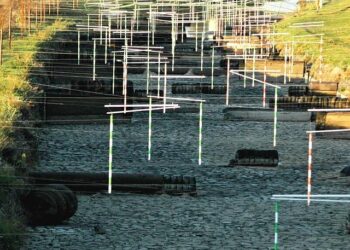As an epicenter of biodiversity, Vietnam hosts a wide array of reptile species. But new research shows that many species that occur nowhere else on the planet are poorly known and lacking protection.The researchers also found that many of Vietnam’s rarest species are absent from the world’s zoo collections and conservation breeding programs, risking their disappearance forever should their wild populations collapse.They call on conservationists and authorities to focus on conservation measures to protect the country’s most vulnerable reptiles, including establishing assurance populations that could be used in the future to repopulate areas of wild habitat from which they have been lost.
Vietnam is the meeting point of two incredibly biodiverse ecoregions, where the tropical ecosystems of Southeast Asia merge seamlessly with the temperate biomes of mainland Asia. Across a terrain of mountain ranges, vast plains and limestone cliffs and caves, animals and plants have evolved into a rich diversity of forms. But more needs to be done to protect key species groups, such as reptiles, from extinction, according to a new study.
Researchers from Vietnam and Germany examining the status, threats and conservation priorities of Vietnam’s impressive total of 484 known reptile species found that many are excruciatingly rare and understudied and that most face serious threats from habitat loss and overharvesting for traditional medicine, the pet trade and human consumption.
In their findings, published in Nature Conservation, the team provide a baseline assessment of the health of Vietnam’s reptiles, identifying a list of the country’s top 50 most threatened reptiles to guide future research and conservation efforts. They also earmark the country’s central Annamite Mountains range as the most important hotspot of reptile diversity in the country, home to 32 species found nowhere else on Earth.
“Vietnam belongs to the global biodiversity hotspots, with a high number of species being discovered every year,” study co-author Thomas Ziegler, coordinator of biodiversity and nature conservation projects for Vietnam and Laos at Cologne Zoological Garden in Germany, told Mongabay in an email. “Our work group has described almost 90 new species of reptiles from Vietnam in the past two decades alone.”
 Mountainous, remote landscapes, such as Cuc Phuong in northern Vietnam harbor rare and specialized reptile species. Image by Rhett A. Butler for Mongabay
Mountainous, remote landscapes, such as Cuc Phuong in northern Vietnam harbor rare and specialized reptile species. Image by Rhett A. Butler for Mongabay
This high rate of species discovery “underscores the conservation importance of Vietnam’s last remaining forests,” Ziegler said. But when it comes to conservation, describing species is just the first step, he added. Next, information must be gathered about their lifestyle, distribution and population size, and attention paid to those found to be confined to restricted areas.
And it seems such attention is urgently required for many of Vietnam’s species of reptile, a third of which are endemic to the country, occurring nowhere else on the planet.
Concerningly, half of the endemic species are known from just one single location, and one-third have never been recorded within Vietnam’s network of protected areas, making them especially vulnerable to extinction.
In total, 74 species of Vietnam’s reptiles are included on the IUCN Red List as threatened with extinction, the research team found, with lizards the most at-risk group, followed by snakes and turtles. Meanwhile, so little is known about dozens of other species that conservationists lack the necessary information to even begin to assess their population status and vulnerability to extinction.
Among the most at-risk species are colorful critters like the endangered psychedelic rock gecko (Cnemaspis psychedelica), a species named for its garish multihued body and described by scientists only in 2010; curious specimens like the critically endangered Gia Lai bent-toed gecko (Cyrtodactylus gialaiensis), a species known only from a single farm site in central Vietnam and described as recently as 2017.
 Scientists believe the Annam pond turtle (Mauremys annamensis) might be extinct in the wild, but many individuals of the critically endangered species are managed in zoos and breeding stations, stoking hopes that it can be reintroduced to its former range.
Scientists believe the Annam pond turtle (Mauremys annamensis) might be extinct in the wild, but many individuals of the critically endangered species are managed in zoos and breeding stations, stoking hopes that it can be reintroduced to its former range.
Combine in-situ and ex-situ conservation
Ziegler and his colleagues emphasize in their study the importance of a combination of field-based conservation, or in-situ approaches, with ex-situ measures, whereby subpopulations of species are safeguarded in well-managed zoos, local facilities or breeding programs where they can be given space to thrive under the care of expert keepers.
Such ex-situ conservation measures can afford conservationists the time needed to address the threats species face in the wild, be they from invasive species, hunting or habitat loss, the study says.
“If a species has gone extinct, this is irreversible,” Ziegler said. “If we still have threatened species in zoos, they are available for reintroductions, once the problem in nature is solved … This is in line with the One Plan Approach to Conservation by IUCN’s Conservation Planning Specialist Group (CPSG).”
By looking at zoo collections worldwide, the researchers found that only one-fifth of Vietnam’s reptile species are currently kept in captivity, mainly in facilities in North America and Europe, including only 23% of the endemic species listed on the IUCN Red List — a group the researchers deem particularly prone to extinction and a priority for ex-situ conservation.
 A Truong Son pit viper or Quang Binh pit viper (Trimeresurus truongsonensis), an endangered snake found in Vietnam. Image courtesy of Thomas Ziegler.
A Truong Son pit viper or Quang Binh pit viper (Trimeresurus truongsonensis), an endangered snake found in Vietnam. Image courtesy of Thomas Ziegler.
In line with the CPSG One Plan Approach, the team is calling on conservationists and authorities to increase the number of such vulnerable reptile species held in zoo collections and breeding programs for what they term “assurance populations,” which could be used to repopulate tracts of natural habitat if safe conditions prevail sometime in the future.
Doug Hendrie, director of wildlife countertrafficking at Education for Nature Vietnam (ENV), a group focused on tackling wildlife crime in Vietnam, said that while it’s undoubtedly important to do everything possible to support endemic and poorly known species through captive-breeding programs, care must be taken to not “lose focus” on the underlying problems.
“We need to be focusing on countering wildlife trafficking and stopping the trade and getting to the source of the problem of biodiversity loss, not coming up with ex-situ solutions for everything, because ultimately speaking, reintroductions require huge investments in time with no guarantees of success,” Hendrie said. “We can’t ignore the fact that we’ve got a long-term problem to resolve [in the wild].”
Tortoises and freshwater turtles are the reptiles most at risk from trade in Vietnam, according to Hendrie, alongside some of the more common lizard species. They’re captured from the wild for human consumption, the pet trade and for use in traditional medicine. Meanwhile, rare endemic species aren’t typically seen in the wildlife trade, Hendrie said, but he noted the ever-present threat of such species being exploited for specialist pet markets in Europe, North America and Japan.
 A psychedelic rock gecko (Cnemaspis psychedelica), an endangered species first described by scientists in 2010 and named for its colorful markings. Image courtesy of Thomas Ziegler.
A psychedelic rock gecko (Cnemaspis psychedelica), an endangered species first described by scientists in 2010 and named for its colorful markings. Image courtesy of Thomas Ziegler.
As a proponent of conservation zoos, Ziegler cited the case of Swinhoe’s giant softshell turtle (Rafetus swinhoei) — a species known only from Vietnam, Laos and parts of China that has been teetering on the brink of extinction for years — as an example of where timely ex-situ conservation measures could have helped avert near-certain extinction.
“When I was in Vietnam in April, the last known female Swinhoe’s softshell turtle was found dead in a lake — really devastating,” he said. Given the only two known individuals left in the world are both males, it seems the opportunity to save the species through captive-breeding programs has been missed, he added.
This is in stark contrast to the critically endangered Annam pond turtle (Mauremys annamensis), another Vietnamese rarity and one of the world’s most threatened species of turtle, Ziegler noted. Although the species has never been recorded in a protected area and scientists believe it might be extinct in the wild, many individuals are managed in ex-situ conservation programs in zoos and breeding stations, stoking hopes that it can be reintroduced to its former range.
Carolyn Cowan is a staff writer for Mongabay. Follow her on 𝕏 @CarolynCowan11.
Citation:
Stenger, L., Große Hovest, A., Nguyen, T. Q., Pham, C. T., Rauhaus, A., Le, M. D., … Ziegler, T. (2023). Assessment of the threat status of reptile species from Vietnam — Implementation of the one plan approach to conservation. Nature Conservation, 53, 183-221. doi:10.3897/natureconservation.53.106923
FEEDBACK: Use this form to send a message to the author of this post. If you want to post a public comment, you can do that at the bottom of the page.
Animals, Biodiversity, Biodiversity Crisis, Captive Breeding, Conservation, Critically Endangered Species, Endangered, Endangered Species, Environment, Ex-situ Conservation, Extinction, Forests, Green, Habitat Loss, Herps, Karst, Lizards, Pet Trade, Reintroductions, Reptiles, Snakes, Traditional Medicine, Turtles And Tortoises, Wildlife, Wildlife Trade, Zoos
>>> Read full article>>>
Copyright for syndicated content belongs to the linked Source : MongaBay – https://news.mongabay.com/2023/09/for-vietnams-rare-reptiles-lack-of-captive-populations-may-spell-doom/































